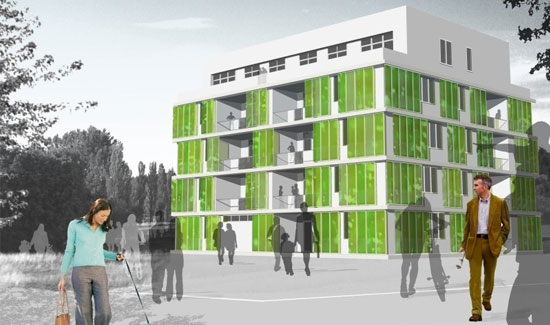Architecture that literally grows has grown as a green building concept, though it still generally sees sporadic moments in the sun but no real mainstream uptake.
The notion of bio-architecture, or growing structures or features of structures has always been a green building ideal. Like many other innovative concepts, however, it has never caught on the way many would hope.
In a recent spate of green building concept realizations, however, the world’s first ever bio-adaptive façade is set to become part of a building in Germany.
The live bio-reactor façade and shading system is slated to grace BIQ, a smart material house for the International Building Exhibition (IBA) in Hamburg, with the IBA noting the house is ‘the first building in the world to have a bioreactor façade as part of a holistic regenerative energy approach.’
This regenerative energy approach includes the production of biomass and heat harvested from the photosynthesis process of micro-algae. Solar thermal heat will also be captured and reused.
In addition to generating energy, the live micro-algae façade provides both lighting and shading control naturally.
Not surprisingly, the building will become a net-zero carbon dwelling.
According to Arup’s Europe research leader Jan Wurm, the realization of this highly innovative, cutting edge development is a welcome addition in an industry dominated by ‘stuck-on-paper’ concepts.
“To use bio-chemical processes for adaptive shading is a really innovative and sustainable solution so it is great to see it being tested in a real-life scenario,” says Wurm. “As well as generating renewable energy and providing shade to keep the inside of the building cooler on sunny days, it also creates a visually interesting look that architects and building owners will like.”
According to Simon O’Hea, director of the louvre-making company Colt International, commercialising the technology behind the façade was no mean feat.
“It’s been a very rewarding scheme to be involved in,” he says. We have put a lot of work into meeting the technical challenges and we now have a commercial-scale, effective solution that uses live algae as a smart material to deliver renewable energy. You can’t get greener than that.”
Putting this kind of cutting edge green technology into practice offered its share of challenges, but it is expected to finally come to fruition next March.
Such a net-zero carbon development could not come at a better time for the industry. The push to move from simple green features to holistic, zero carbon practices has come to a head around the world and this new technology could be a key factor in making that goal a real possibility.

